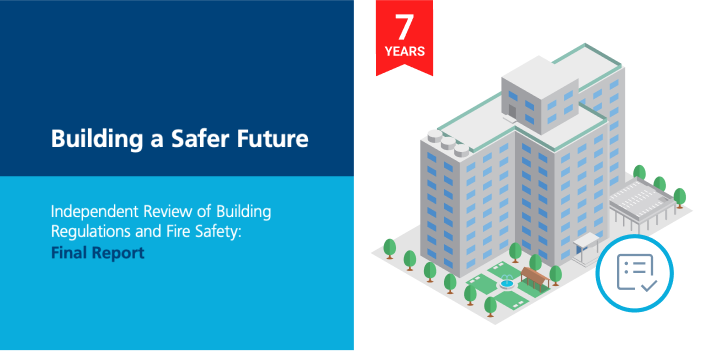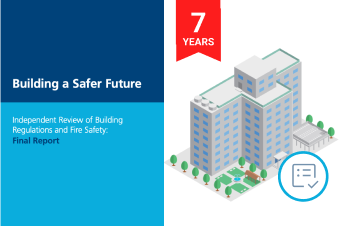Seven Years On: The Building a Safer Future (Hackitt) Report’s Enduring Impact on UK Building Safety
On May 17, 2018, Dame Judith Hackitt published the final version of her “Building a Safer Future” report, in response to the Grenfell Tower tragedy. Seven years later, we assess the changes made in building safety and the challenges that persist for industry and residents.

The Hackitt report identifies 8 key themes to support ‘Building a Safer Future’
- A New Regulatory Framework
- Clearer Duty Holders and Responsibilities
- The ‘Golden Thread’ of Information
- Resident Engagement and Transparency
- Competence Across the System
- Culture Change in the Construction and Fire Safety Sector
- Product Testing, Certification, and Marketing
- Enforcement and Sanctions
On the 18th December 2018 the Secretary of State James Brokenshire confirmed that the Government would adopt the recommendations within the Hackitt report in full.
Key (not exhaustive) Building Safety Outcomes Since 2018:
- Building Safety Act 2022: Established a comprehensive regulatory framework, introducing the Building Safety Regulator and the Office for Product Safety and Standards to oversee compliance and safety standards.
- Gateways: Mandatory ‘Stop-Go’ gateways for Planning, Construction and Occupation phases.
- Golden Thread of Information: Mandated the creation and maintenance of detailed digital records throughout a building’s lifecycle to ensure transparency and accountability.
- Safety Case/Safety Case Report: Mandatory identification and management of Building Safety (Fire & Structure) risks. Summarised in a narrative Safety Case Report
- Resident Engagement: Placing residents of Higher-Risk Buildings (HRBs) at the centre of decision making and with enhanced rights of information disclosure.
- Revised Fire Safety Regulations: Multiple implements and planned changes to Approved Document B. For example lowering the threshold for mandatory sprinkler systems in residential buildings from 30m to 11m and second escape staircases will be mandatory in all new residential buildings over 18m in England from 30 September 2026.
- Combustibles Ban: Prohibition of the use of combustible materials in the external walls of high-rise residential buildings over 18 metres came into force in December 2018.
Ongoing Challenges
- Regulatory Delays: The recently established Building Safety Regulator is struggling to cope with workload in both Gateway 2 (Construction) and Building Assessment Certificate issuance (Occupation) leading to stalled projects, excess costs, reputation damage and high levels of industry dissatisfaction.
- Regulatory Scope: Hackitt proposed her new regulatory regime be applied to all multi occupancy residential buildings 10 storeys or more (30m+) in height which would have brought approx 2-3,000 blocks into scope. This definition was later changed by the Government to 7 storeys/18m+ which brought an additional 10,000 buildings into scope. There is now debate about further scope expansion due to the latest Grenfell Inquiry recommendations. Simply put, there are too many blocks in scope for the regulator or the industry to cope with and in many cases the regime is disproportionate to the risk.
- Money: Government, fire engineers,lenders and insurers have wrestled with how to handle a historical stock of often poorly built and poorly documented buildings, huge sums of money has been spent from tax payers, developers and residents pockets to assess buildings and make them ‘safe’ through remediation. Debate rages on with regard to how ‘safe’ is defined and why new builds over 18m have combustibles banned whereas existing buildings can leave combustibles on subject to a PAS 9980 risk assessment.
- Cultural Resistance: A so-called “rotten culture” characterised by cost-cutting and blame-shifting persists in parts of the construction industry, hindering progress toward safer buildings.
Looking Ahead
The Hackitt Report catalysed a paradigm shift in building safety, emphasising the need for systemic change. While significant progress has been made we must remember we are now 7 years on from the publication of the report and the new regime is somewhat stuck in the mud of the Government’s own making.
We need to urgently review the proportionality of the regime and especially look at the reasonableness of costs associated with compliance at the sub 30m height range. For example this building in London has 8 flats over 5 floors but falls within the Building Safety Regulator regime. Conservative estimates put the cost of compliance at over £4,000 per leaseholder per year.



